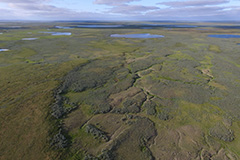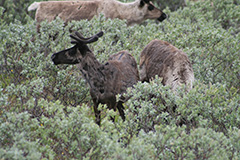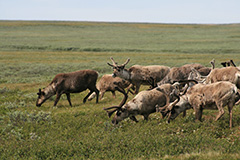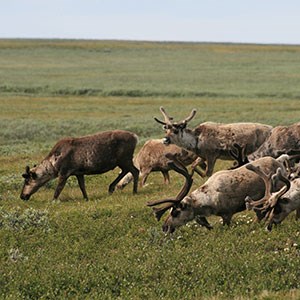Earlier studies have linked climate change in Arctic regions to an expansion of shrubs and an increase in biomass as tundra becomes greener. Herbivores like reindeer and caribou are often considered able to suppress this vegetative greening through trampling and grazing. The effect of herbivory on shrubs have been quantified in local experimental sites, but there are still few studies quantifying reindeer use at the landscape scale that can shed light on their potential to suppress Arctic ‘greening’.
An international team of researchers have studied reindeer habitat use within the low Arctic tundra zone of Yamal, West Siberia. Using reindeer faecal pellet-group counts together with field and satellite measures on the vegetation they have evaluated reindeer potential to supress the growth and regrowth of shrubs in the tundra. Depth of seasonal thaw (active layer) was also measured and related to the reindeer use, as intense use of for example denuded land also could favour deeper thawing of the permafrost. “We used Landsat satellite imagery to connect reindeer habitat use with the remotely sensed land surface information, including vegetation productivity and reflective properties i.e. albedo. This tells us how much energy is potentially absorbed by the tundra, thus, warming the underlying permafrost,” Researcher Mariana Verdonen from the University of Eastern Finland says.
“These measures can help us to understand herbivore impact on the growth and recruitment of deciduous shrubs, many of which serve as fodder, in favourable habitats, such as naturally denuded landslides in permafrost areas,” Docent Anna Skarin from the Swedish University of Agricultural Sciences says.
The results confirm intensive use by reindeer of areas with higher productivity, low erect shrub tundra and upper slopes, ridges and valleys, while the use of tall willow areas was less intense. This suggest that reindeer are unlikely to suppress growth of already tall willows, while they may suppress shrubs low in stature. The study did not find any direct relationship between permafrost thawing and reindeer use, but intensively used sites seemed to have a shallower active layer. “Future research is needed to evaluate the role and efficiency of reindeer as ecosystem engineers capable of mediating the effects of climate change”, Professor Timo Kumpula, from the University of Eastern Finland says.
Contacts
Anna Skarin, Associate Professor
Department of Animal Nutrition and Management, SLU, Uppsala
Anna.skarin@slu.se, +46 73 581 13 66
Mariana Verdonen, Early Stage Researcher
UEF Connect, Finland
mariana.verdonen@uef.fi, +358 50 568 9783, CV page
Timo Kumpula, Professor
UEF Connect, Finland
timo.kumpula@uef.fi, +358 50 372 8566, CV page
Scientific article
Skarin, A., Verdonen, M., Kumpula, T., Macias-Fauria, M., Alam, M., Kerby. J & B.C. Forbes (2020). Reindeer use of low Arctic tundra correlates with landscape structure. Environmental research letters.
Video
Watch a movie about the research project
Photographers: Jeffrey Kerby, Anna Skarin, Hannes Skarin & Mariana Verdonen
Press images
(May be published without charge in articles about this press release, please acknowledge the photographer)

Landslide area in the study area, Yamal, Russia. Photo: Pasi Korpelainen.

Reindeer in the tall erect willows (Salix spp.) areas. Photo: Hannes Skarin.

Reindeer grazing in terrain with low-growing shrubs. Photo: Hannes Skarin.



